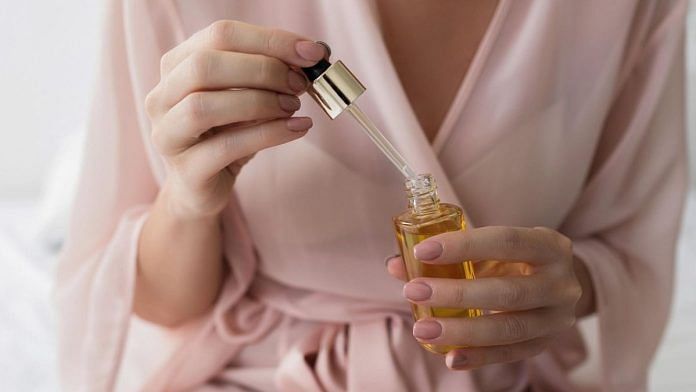Glycolic acid is the queen bee of skincare acids – small but powerful. Generally derived from sugarcane, this alpha-hydroxy acid packs some major benefits for your skin and scalp.
Now a constant on Instagram reels, glycolic acid gently exfoliates the top layer of your skin without causing the irritation that physical scrubs do. But it wasn’t always such a big deal. This magical ingredient made its debut in 1992, when the skincare brand Avon launched ANEW, a first-of-its-kind glycolic acid-based skincare line.
While this AHA can be hugely beneficial, don’t mistake it to be gentle. Some glycolic acid formulations can be stronger than others, and can lead to irritation, sensitivity or acne breakouts if overused.
That said, this wonder potion still deserves a place on your dresser – for very many reasons.
Get smoother skin, feet
Glycolic acid exfoliates dead skin and fades acne scars, helping keep breakouts at bay. It’s also great for anti-ageing – smoothing fine lines and wrinkles, and evening out skin tone and texture.
But moderation is key. I’m honestly quite taken aback by the sheer number of glycolic acid products in the market today – sprays, gels, pads, even deodorants. Since no skincare product seems to have escaped this fad, be careful with the dosage you apply to your skin and always consult your trusted dermatologist before doing so.
Glycolic acid can also work to smoothen the tiny dark bumps on your arms and legs – popularly known as ‘strawberry’ or ‘chicken’ skin. However, know that it can’t fully fix the problem. This condition is largely influenced by genetics, ageing, and the amount of sun exposure or blood circulation in the affected areas.
While glycolic acid-based lotions and body washes can help to an extent, they can’t address the root causes. Laser treatments, diligently followed up with anti-inflammatory and hydrating skincare, can help manage the condition better.
If you’re someone who’s struggling with cracked heels, glycolic acid might be the fix you need. It dissolves dead skin, helps soften calluses, and offers significant hydration. Just apply directly to your heels and follow up with a thick moisturiser for soft, crack-free feet.
Also read: Soap vs shower gel—what’s better for your skin?
Get a healthy scalp
Your scalp is naturally known to produce more oil than the other areas of your skin. And if you add all the residues left over by shampoos, conditioners, and styling products, you’re essentially looking at a veritable cocktail from the dark side. For those of you already dealing with dandruff, the extra scaling of your skin brought about by fungal growth will only make things worse.
This is where glycolic acid comes in as the gentle but powerful exfoliator. It removes dead skin, buildup, and extra icky debris that your hair can do without. Just dab a low-concentration glycolic acid serum onto a clean scalp, leave for 30 minutes, and wash off with shampoo for dandruff and grime-free hair. Avoid usage if you’re under 21, pregnant or nursing, or have a sensitive or irritated scalp.
People with bald spots can also use glycolic acid in moderation, but must apply it at night and wash off in the morning before heading off into the sun. This is because glycolic acid increases UV sensitivity, and bald spots leave the scalp particularly prone to sun damage.
Those suffering from heavy dandruff can use a combination of apple cider vinegar and cetrimide (which is found in Savlon), instead of glycolic acid. They can be far more effective.
Also read: Acid is the new skincare routine. Forget Ponds, Lakmé
Some dos and don’ts
Glycolic acid is a powerful friend to have in your skincare routine for exfoliation, brightening and anti-ageing – but it’s crucial to use it correctly.
- Start initiation slowly, adjust frequency
If you’re completely new to glycolic acid, start with a two to three per cent concentration and gradually build up tolerance by using it twice or thrice a week. Do not use daily and always apply at night. Those with sensitive skin or conditions like rosacea, psoriasis, or eczema should steer clear of glycolic acid altogether.
- Pair it with sunscreen
Glycolic acid increases sun sensitivity, so don’t even think about using it without applying your sunscreen after. If you skip SPF, then you’re inviting hyperpigmentation, sunburns, and even accelerated ageing.
- Don’t combine with harsh actives
Do not combine glycolic acid products with retinoids, salicylic acid, lactic acid, or vitamin C serums.
Finally, like I always tell you, consult your trusted dermatologist before using any of this on your skin.
Dr Deepali Bhardwaj is a Consultant Dermatologist, Max Hospital, Saket. She is also an anti-allergy specialist, laser surgeon and internationally trained aesthetician. She tweets @dermatdoc. Views are personal.
(Edited by Zoya Bhatti)






